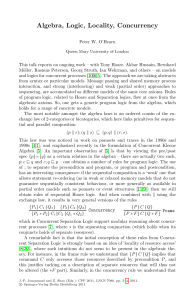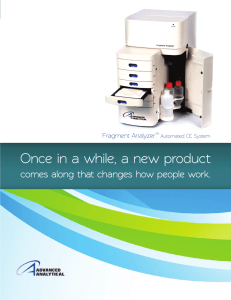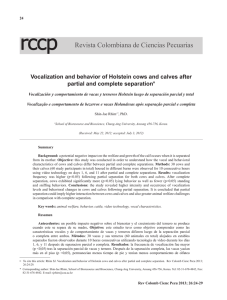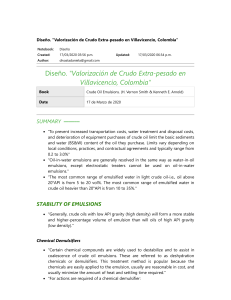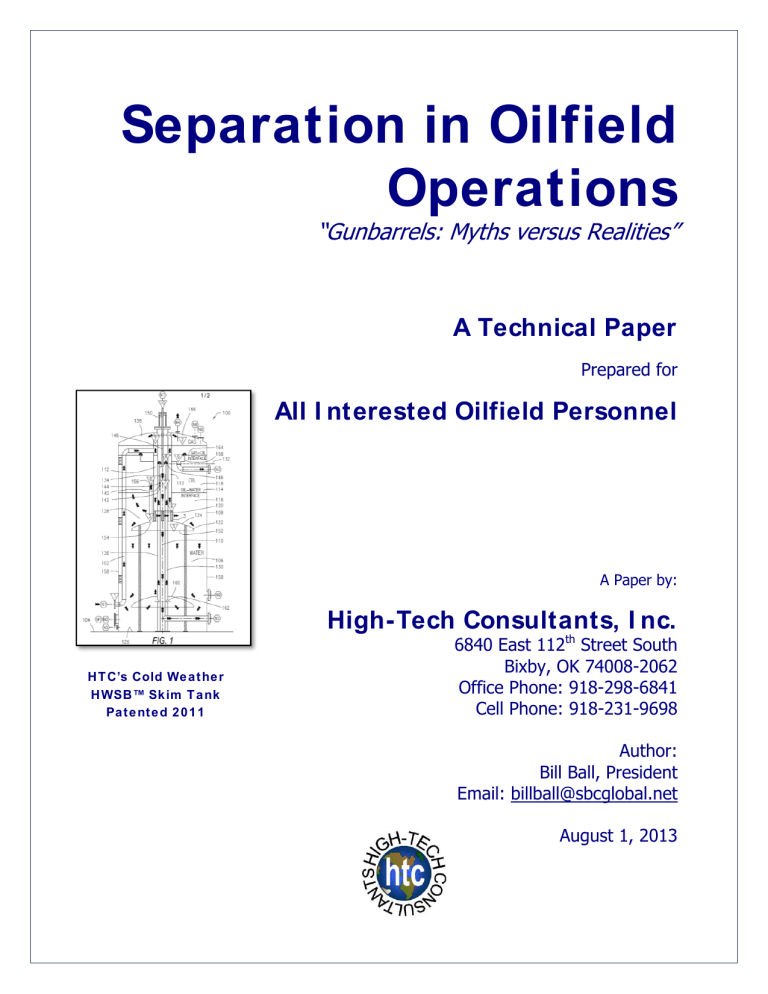
Separation in Oilfield Operations “Gunbarrels: Myths versus Realities” A Technical Paper Prepared for All I nterested Oilfield Personnel A Paper by: High-Tech Consultants, I nc. H T C’s Cold We a t he r H WSB™ Sk im T a nk Pa t e nt e d 2 0 1 1 6840 East 112th Street South Bixby, OK 74008-2062 Office Phone: 918-298-6841 Cell Phone: 918-231-9698 Author: Bill Ball, President Email: billball@sbcglobal.net August 1, 2013 High-Tech Technologies Proven Oilfield Separation Systems are more efficient than others. paper discusses a few of them. PREFACE Knowledge is everything! With oil prices hovering around $100/barrel, it’s not surprising that the oil industry has a penchant for producing and selling every drop. Yet, there is a very large knowledge gap regarding “how to” make this happen. This paper attempts to fill some of that gap, improving the readers understanding of how to capture every drop of oil in todays’ operations. It attacks the myths of the past, myths that tend to perpetuate themselves in the “we always did it that way” mindset we encounter every day. It prompts us to become better at what we do so we can meet our goals of maximized oil revenue, facilities performance, and profitability. BACKGROUND HI STORY The practice of oil-water separation began with the first oil well in Titusville, PA over 150 years ago out of necessity. It’s the same today. Crude oil producers must separate produced gas, solids, and water from oil in order to sell it and avoid purchase price penalties. As an industry, we also need to separate contaminants from produced water to minimize disposal or injection well plugging. These separation processes can be accomplished with many different types of equipment and in many different ways. Some of these This In any separation system, the first needs are to select the proper size and the right design for the appropriate separation process. Before deciding what the proper size and the right design are, it is useful to know how the more common and widely accepted designs evolved. For the last 15 decades or so the oil producing industry has used a design which is known as the atmospheric “gunbarrel”, or “wash tank”, to separate and sell crude oil. In this design the focus was on removing water and BS&W from produced crude oil, with no concern for water quality or oil carryover whatsoever. In this system produced oil, water, gas and any solids first flows into a degassing chamber referred to as the “gas boot”. Gas flows up and is equalized with the gas phase in the tank through a separate pipe. It commingles with gas evolving from the crude and is piped off to a flare, vapor recovery systems and on to sales, or in many cases to an atmospheric vent. Liquids flow down and out of the gas boot into a “downcomer” pipe which ends near the tank bottom where the liquids exit under a baffle, or “spreader”. ©2013 HTC, Inc. This document was prepared by HTC for the customers and clients of KBK Industries and HTC, Inc. Separation I n Oilfield Production Operations August 1, 2013 Page 3 “Myths versus Realities” Many spreaders were designed with serrated bottom edges. These were inverted “V” shaped notches, like saw teeth. The v-notches were intended to “meter” or distribute the flow of oil uniformly through the water phase. The design philosophy was that “washing” the crude oil through water would allow the water to flow out of the crude oil. Thus the name “wash tank”. Some designs placed the gas boot and downcomer outside the tank, while others placed the gas boot on top of the tank (see Figure 1 on Page 3). In both cases, when viewed from the top, the tank and gas boot circles appeared similar to the circles one sees looking down the barrel of a gun. This was the basis for the term “gunbarrel”. The gunbarrel, or wash tank, design was originated in the 1860s. Trial and error applications saw its size increase larger and larger until it finally performed as desired. This propagated the oilfield design philosophy that “bigger is better”. For better or worse, this simple design remained unchallenged for decades. It was and is a standard of the industry for atmospheric crude oil dehydration. But, as we’ll see, it is unfortunately very inefficient! The “Gunbarrel” design was finally challenged in the 1970s, when the uncommonly high price of crude oil justified field and laboratory research into the relative efficiency of this and other “standard” oilfield equipment designs. The results were startling, and most were disappointing! Retention time studies were conducted in separators, gunbarrels, wash tanks, free water knockouts, heater treaters, and storage and skim tanks. The results showed that the hydraulic efficiency of all designs were extremely low, most ranging from 1% to 3%, with a few ranging to only 20%. Bigger had been thought to be better, but these studies refuted this concept. In most cases, bigger was proven to be worse! GAS OI L WATER TYPI CAL GUNBARREL/ WASHTANK FI GURE 1 © 2013 HTC, I nc. This document was prepared by HTC for its loyal clients and prospective clients worldwide. Separation I n Oilfield Production Operations August 1, 2013 Page 4 “Myths versus Realities” These studies also identified the flow characteristics leading to low efficiencies, and helped explain some of the reasons for these gross inefficiencies. These studies also proved that all fluids predictably take the path of least resistance. They traverse in a short, narrow flow path between the vessel inlet and outlet. This was something of a revelation since it was presumed that fluids naturally distributed uniformly in these vessels, and flowed like a plug or piston through the entire cross section. In addition, these studies proved that flowing path and velocity determine the degree or efficiency of separation, and that they are almost never constant in the real world of oilfield operations. What was constant was that when the velocity of the bulk production exceeds the separation velocity of any fluid or solid, the mixing energy offsets or eliminates most or all separation. This was a revelation. It confused many of those involved in these studies. After all, oil industry separation designs had always been assumed to work efficiently! As this new level of knowledge was applied to traditional equipment designs, the gunbarrel (wash tank) results were also surprising. In the past, gunbarrel sizing had been based on the supposition that oil needs eight to 24 hours of piston displacement retention time to dehydrate, depending on API gravity. Decades of observation had determined that these retention times could be related to the gravity of crude, from 20° API to 40°API. It was known that in heavier oil applications, all bets were off, as much more time was needed. This had meant larger and larger tanks. Those same studies showed that the metering concept of the serrated 9sawtooth) distributor baffles was invalid too. In fact, it was found that crude oil entering a gunbarrel (and most other vessels) oil wets ALL of the surfaces, including the serrated spreader, and then, rather than being metered out into the water phase by the serrations, the crude was found to really flow in rivulets attached to the steel spreader structure, GAS OIL WATER CRU DE FLOW PAT H FI GU RE 2 © 2013 HTC, I nc. This document was prepared by HTC for its loyal clients and prospective clients worldwide. Separation I n Oilfield Production Operations August 1, 2013 Page 5 “Myths versus Realities” up the outside of the spreader to its crest where if travelled up the OD skin of the downcomer and into the oil layer above, or disengaged from the edge of the spreader and into water layer. If the tank was designed like the one in Figure 2, oil disengaged at the highest or “sharpest” edge surface in large droplets or globules. These oil droplets then flowed rapidly and vertically into the oil phase. From there very little, if any, horizontal distribution occurred, and the oil flowed diagonally to the outlet nozzle, circumventing the bulk of the tank’s volume. It was found that only a very small portion of the storage volume actually came in contact with the crude. In many cases the inlet crude was found to actually reside in the oil phase for just a few minutes. This finding refuted the old design philosophy of sizing based the 8-24 hours of crude oil retention time rule of thumb. It became clear that any water in the oil phase had to separate in a matter of minutes, rather than in a matter of hours. And, since the age-old belief that 8-24 hours of retention time was proven incorrect, it became obvious that gun barrels had to have been vastly oversized to work, given the extremely low hydraulic efficiency of their design. At this point, design emphasis began to shift away from the assumed oil retention time of the past. Some designers began to look for new methods of increasing the actual distribution of oil within a smaller vertical column (volume) of stored crude to improve dehydration. It was believed that this would result in smaller gunbarrel designs, and a smaller investment in the oil stored in them. Lucite models were constructed so small scale lab tests of various internals could be performed. In general terms, the results were quite encouraging. And not surprisingly, each investigator was amazed at how inefficient the old original gunbarrel design actually is (see Figure 3). It became clear that when fluid flows and distribution were more uniform distributed the results were a dramatic increase in actual crude retention time. As these studies progressed it was eventually discovered that truly uniform distribution of incoming crude and OIL Gas Oil WATER ORI GI N AL GU N BARREL DESI GN Figure 3 © 2013 HTC, I nc. This document was prepared by HTC for its loyal clients and prospective clients worldwide. Separation I n Oilfield Production Operations “Myths versus Realities” emulsion through the entire cross section of the oil layer increased retention times by a factor of 10 to 35. Furthermore, and equally surprising, it was also found that process capacity and separation efficiency increased even more when the inlet crude and emulsion is NOT washed through the water phase, but is introduced into the emulsion rich layer just above the water phase. These studies proved that both naturally occurring and artificially added emulsion breaking chemicals tend to concentrate in this layer. These chemicals have the effect of reducing the surface tension of droplets, promoting coalescing (the growth of droplet size), and therefore vastly improving separation. Finally, it was observed that flow velocities needed to be carefully considered. A velocity relationship was observed wherein a fractional oil flow rate directly proportional to API gravity accomplished the desired gravity separation of water from oil. This brought a whole new engineering dimension to the concept of “proper” design. The conclusion of this work proved that new wash tanks/gunbarrels can be sized much smaller, reducing the capital investment for tankage. The investment of “oil-in-inventory” in smaller gunbarrels is also obviously reduced. Further, these high-tech gunbarrels produce a very high quality oil effluent regardless of summer-winter swings in temperature and viscosity, for most oils August 1, 2013 Page 6 in the 27° API and above range. However, since the separated water short circuits to the outlet, the quality of effluent water in these gunbarrels was shown to still be extremely poor. It typically ranged from 1500 ppmv to 5000 ppmv oil in the effluent water, or more. Water quality had been ignored in the early decades of the industry, but with the advent of water flooding in the late 1940s, it took on a new meaning. When produced water contained so much remnant oil it was found to be plugging injection and disposal wells, and as the price of crude rose from its government regulated pre-war $1.25/barrel level to an unregulated and much higher value, the issue of removing oil from water, and the issue of water quality in general, finally reached a level of significance to producers. As the industry entered the “boom years” of the 1970s, several new equipment designs were developed to improve water quality. These designs experimented with matrix plate coalescing, deep bed sand-based coalescence, Lamella plate separators, serpentine vane coalescing, and a wide variety of other internals and processes. All of these showed promise, but when applied in the real world, often proved to be impractical due to high capital costs, premature plugging of internals, and other related costs. Then came the “bust years” of the 1980s when the concept of survival in a depressed industry outranked the need © 2013 HTC, I nc. This document was prepared by HTC for its loyal clients and prospective clients worldwide. Separation I n Oilfield Production Operations August 1, 2013 Page 7 “Myths versus Realities” for research. As oil prices sunk to record lows many of the best minds in the oil industry left, seeking work in other, less volatile industries. And with them departed a good deal of the industry’s knowledge, never to return. In contrast, HTC persevered in its effort to continue research and to develop better, more efficient systems. In 1993 these efforts resulted in a series of patents finally advancing the design engineering of gunbarrels, wash tanks, skim tanks, de-sanders, flow splitters, and many others into the realm of the highly efficient. These designs were honed throughout the 1990s to become performance standards in the new millennium … evolving finally into a family of proven and widely accepted 21st century HTC design technologies. SEPARATI ON AND STOKES’ LAW The static separation of immiscible fluids (fluids that are not soluble in one another), and/or suspended solids, can be predicted by applying Stokes’ Law of physical separation. Predicting static separation is very straight forward. An example is predicting the separation of gravel dumped into a tank of water. The tank is “static”, which means there is no motion inside. By applying Stokes’ Law anyone can calculate how long it will take for the gavel to reach the bottom of the tank. It is obvious that the gravel will settle to the bottom because gravel is heavier than water. It is logical that the larger, heavier pieces of gravel will settle (separate) faster, and the smaller, lighter pieces will settle (separate) slower. An understanding this simple principle is a good beginning to understanding “gravity separation” and Stokes’ Law. However, the word “static” is the key to distinguishing the merits of Stokes’ Law from the dynamic separation typically demanded in oilfield separation systems where fluid stays in motion all the time. Most oilfield process separation systems are not static. There is constant if irregular motion inside process vessels. Nothing is static! So, a law that predicts the rate of static separation had to be modified for oilfield operations where almost nothing is static. Fluids are constantly flowing all the time. Because of this, Stokes’ Law does not go far enough by itself to be applied to most process separation challenges in our industry. Let’s review. A typical oilfield process separation system can be accurately described as those with continuously flowing conditions where all fluids are in motion. But, Stokes’ Law only predicts separation in a static, non-moving environment. Nevertheless, a good understanding of the concepts set forth in Stokes’ Law is considered critical to the understanding of separation. So, we start with it. STOKES’ LAW Stokes Law was published in 1851. It represents the velocity of a rising or falling fluid or particle under static conditions with the following formula: © 2013 HTC, I nc. This document was prepared by HTC for its loyal clients and prospective clients worldwide. Separation I n Oilfield Production Operations “Myths versus Realities” August 1, 2013 Page 8 density difference of the two phases (d1 –d2) times the square of the size of the fluid/solid particle (r2) times the gravitational constant (C), divided by the viscosity (N) of the continuous phase. Where: F = 6πrηv, … and where F is the frictional force r is the particle radius η is the fluid viscosity, and v is the particles speed Vs is the particles settling velocity, g is the acceleration of gravity, ρp is the density of the particles, and ρf is the density of the fluid Stokes’ postulated that if the particles fall through a viscous static fluid by their own weight, then he could derive their settling velocity by equating the frictional force with gravitational force. In order to relate Stokes’ Law to the dynamic separation problems encountered in typical oilfield separation it needed to be modified. A good deal of work was necessary to accomplish this. The modified Stokes’ Law can be represented in formula form as follows: V = Cr2(d1 – d2) N1 The Stokes’ Law formula focuses on two immiscible phases at one time. When more than two are present, each is calculated independent of the others. Modified Stokes’ Law states that the velocity (V) of separation is equal to the In both versions, all of the variables have a decided impact on separation. However, the greatest impact is the size of the particles to be separated, since the relationship is not linear (one-toone), but instead is exponential (the square) of the droplet or particle size. That is, as the particle size doubles, the separation velocity is increased by four times. As size triples, the separation velocity is nine times as fast. As size quadruples, the particle separates sixteen times as fast, and so on. The inverse it also true. A reduction in size of half results in a separation time four times longer. A reduction in size to onefourth the original size results in a separation time sixteen times longer, and so on. It is very important to grasp this concept in the real world, since many of the ways we handle and treat produced fluids may reduce or enlarge the size of the particles and droplets we are eventually going to try to separate. Separation in the oil patch involves the separation of oil, gas, water, and solids from one another. Separating oil from water is necessary to achieve the oil quality necessary so the oil can be sold and shipped to refineries without BS&W penalties. Separating oil and other contaminants from water is necessary © 2013 HTC, I nc. This document was prepared by HTC for its loyal clients and prospective clients worldwide. Separation I n Oilfield Production Operations “Myths versus Realities” so the water can be re-injected or disposed of without the plugging effects of entrained oils and solids on injection or disposal wells. Furthermore, whereas oil has a commercial value, any oil left in the water not only causes injection or disposal well plugging, but also reduces the income stream from the sale of the oil now lost to the water phase. So clearly, larger particles sizes are preferable. One of the ways we grow or reduce the size of the droplets or solids we are going to try to separate is with the addition of oilfield chemicals. In most non-chemically stabilized mixtures of oil in water, the majority of the droplets of one in the other are larger than 150 microns. These droplets separate rapidly simply because of their size. However, when the droplets or particles are smaller than 150 microns, separating them becomes a real challenge. Over treatment with oilfield chemicals is a major culprit reducing sizes, and thereby in causing chemically stable emulsions and poor separation. Many other circumstances also cause smaller droplets. Pumping is another real world culprit. For instance, when mixtures with large droplets are moved from one place to another, the act of moving them may provide the necessary physical force necessary to divide the large droplets into smaller and smaller droplets. Imagine the impeller of a typical centrifugal pump, turning at 3550 RPM through a mixture of produced water and oil. The rapidly turning impeller shears larger droplets into smaller and smaller droplets as it August 1, 2013 Page 9 turns, pumping the mixture down the line. The smaller droplets separate slower, consistent with Stokes’ Law. In most oilfield operations there are many circumstances that make separation more difficult than it could be. For instance, oil flows from the subterranean reservoir at an everincreasing velocity into the well bore. There it A) flows to the surface via its own energy, encountering a choke where large droplets are broken into tiny droplets by the forces of pressure reduction (just as in the homogenization of milk), or B) is picked up by a plunger or centrifugal pump which exhibits enormous shearing forces in the process of moving fluid through dozens of impellers, or past the ball and seat discharge check valve. In these and most other cases the result is the same droplet size reduction. Any reduction of the size of the droplet or particle slows down the separation process. When the droplets/particles are smaller than 150 microns in the real world, the mixture is redefined as a suspension, and separation occurs at a snail’s pace. To get a grasp on the sizes we are discussing here, it may help to know that one micron is 1/1000th of a millimeter, or 1/24,400ths of an inch. While these are very tiny particles or droplets, a person with normal vision can see a 75 micron particle with the naked eye. So, while the 150 micron threshold is tiny, it is not beyond the boundaries of unaided human vision. © 2013 HTC, I nc. This document was prepared by HTC for its loyal clients and prospective clients worldwide. Separation I n Oilfield Production Operations “Myths versus Realities” Before we go further, we need to understand a few more terms. In the world of liquid or gas separation models, one or more contaminants are usually suspended in a fluid (liquid or gas) that makes up the largest percentage of the mixture or suspension. This larger, or majority fluid is called the “continuous phase”. Additionally, when a mixture is made up of a continuous phase with larger than 150 micron droplets or solid particles, it is considered an unstable mixture or emulsion. When the contaminants are smaller than 150 microns, the mixture is considered a suspension. The smaller the micron size, the more stable the suspension, until finally the suspension is so stable that no Stokes’ Law separation occurs. Let’s focus on suspensions that do separate. These suspensions are nonstable mixtures of the continuous and non-continuous phase. The degree of stability of the mixture depends mostly on the size of the non-continuous phase. Again, when average size of the non-continuous phase particles is larger than 150 microns separation will occur readily, usually within minutes. When the average non-continuous droplets range from 50 to 150 microns, separation times often increase from several hours to several days. When the droplets range from 10 to 50 microns, the mixture is considered dispersion where separation may take many days or even weeks. And, when the particle size of the dispersed fluid is August 1, 2013 Page 10 smaller than 10 microns, it is considered a colloidal suspension, where separation may not occur in any practical period of time. Homogenized milk is a good example of a colloidal suspension. Milk is a mixture of butter fats (organic oils) and water. In the homogenization process, the mixture of raw milk (butterfat and water) is pumped through a tiny orifice under very high pressure. This shears the butter fat particles until they are smaller than 1 micron. The result is a stable, non-separating dispersion of two immiscible fluids (please see: http://www.foodsci.uoguelph.ca/dairyed u/homogenization.html for more information). This is the kind of suspension often caused by chokes in oil/gas wells, by the shearing action of multistage downhole centrifugal pumps, by cavitating surface transfer pumps, and by leaking balls and seats in rod pumped wells. When we look at the actual conditions typical of most oilfield operations, we find that most oil in water and water in oil have particle (droplet) sizes above 150 microns when the produced fluid reaches the surface. These are mixtures which should separate rapidly. However, this is not always the case. When a droplet is sheared from a mixture size of 200 microns to a suspension size of 50 microns, we know that the rapid separation we might have otherwise expected will not occur. If the 200-micron droplet separated in 5 © 2013 HTC, I nc. This document was prepared by HTC for its loyal clients and prospective clients worldwide. Separation I n Oilfield Production Operations August 1, 2013 Page 11 “Myths versus Realities” minutes, the 50-micron droplet (now one fourth of the original size) will take a calculated sixteen times longer, or 625 minutes (the square of the square of the original separation time, according to Stokes’ Law). This dramatic difference is the reason we will want to concentrate on the methods of fluid handling in production operations. This helps explain why it is sometimes difficult to separate very light oil from very heavy produced water. Again, poor fluid handling techniques can cause droplet/particle shearing, lengthening the required times for separation. When this happens, producers tend to spend too much money on oversized surface facilities. This is usually a waste of money. So, it pays to understand fluid handling. A few key examples of fluid handling mechanics that cause droplet shearing, longer than expected separation times, and larger (more costly) than necessary surface facilities, are: The flow of produced fluids through small restrictions, like: the ball and seat of a rod pump, through a choke the flapper of a check valve a pinched flow control valve centrifugal sub-surface and surface pumps surface gear pumps trim sets in liquid level control valves on separators, free water knockouts, heater treaters, etc. Pumping produced fluids from one vessel to another, as in: circulating tank bottoms drawing interfaces off of gunbarrels recirculating interfaces recycling sump liquids back to the separation processes In addition, most chemical additives used in oilfield operations also have the effect of reducing particle sizes. Examples are: Emulsion breakers when high instantaneous dosages are applied, such as: Slugging a gunbarrel to break a difficult emulsion Slugging a heater treater to clean up the oil pad Overtreating the entire production steam Overtreating a single well steam Corrosion Inhibitors: These chemicals often depend on water wetting surface active agents to clean organic deposits from the corrosion sites. These powerful surface active agents (surfactants) promote very stable oil-water and oil-water-solids emulsions. Scale Inhibitors: Both organic inhibition polymers and inorganic scale inhibitors are formulated to disperse solids, preventing agglomeration. This is the exact © 2013 HTC, I nc. This document was prepared by HTC for its loyal clients and prospective clients worldwide. Separation I n Oilfield Production Operations “Myths versus Realities” opposite from coalescence (droplet or particle size growth). While stable dispersions are not defined as emulsions, the results are much the same, since the dispersants prevent coalescence (droplet or particle size growth). Acids: Acids are used for well stimulation. By definition, acids have very low pH values. A low pH environment promotes dispersion. Therefore, droplet and particle coalescence will not normally occur in low pH environments. Acids applied in oilfield production operations nearly always contain surface-active chemicals used to remove the oily deposits from the reservoir rock and scale the acids are designed to attack. These surfactants promote chemically stable emulsions, and this problem is enhanced further by the presence of the very small (usually less than one micron) solids particles carried back to surface treating facilities by spent acids. Frac Polymers: Like scale inhibition polymers, frac fluid polymers create very difficult and stable inverse emulsions. These are often so stable that they can only be broken by breaking down the polymer chains. This both costly and labor intensive, since all frac companies continuously alter their frac polymer chemistry. This situation is compounded by the huge initial amounts of polymer containing August 1, 2013 Page 12 flowback water the producer must scale up to treat. Chemically stabilized emulsions add time to the physical separation, as has been described in the preceding explanation of Stokes’ Law. This report can shed light on the causes, but only real-world experience can help predict increased separation time at the Flanagan Lease. OI L-WATER SEPARATI ON RETENTI ON TI ME AND It can be said that effective physical separation is a function of efficient fluid distribution and time. The required separation time is often referred to as “retention time”, or the amount of time a fluid is allowed to reside in a process vessel before for the desired separation takes place. A key factor contributing to oil-water separation in facility design is the prediction and determination of real retention time. From the above it is obvious that droplet or particle size is the most critical factor when attempting to predict what retention time may be needed, since it is the only exponential function in Stoke’s Law. It is also obvious that the required retention time must be provided or separation will not occur. If the flow through surface facilities short-circuits, separation will not adequately occur regardless of size. If the surface facilities are too small, separation will probably not occur since © 2013 HTC, I nc. This document was prepared by HTC for its loyal clients and prospective clients worldwide. Separation I n Oilfield Production Operations “Myths versus Realities” August 1, 2013 Page 13 sufficient time will not be available, even if distribution is excellent. If facilities are properly sized but the attention to distribution is lacking, separation efficiency will suffer. And, if the facilities are too large, money is wasted. designs. These will save money upfront and during the entire life of each lease or field. It is clear that too much money has been wasted on poorly designed, oversized surface facilities throughout the history of the oil industry. Unfortunately, this trend has not slowed. In fact, in “boom” times like these, just the reverse is true. This happens because the industry is limited in human resources, so it focuses on the larger issues, letting issues like this go unattended. This also has happens because of the widespread lack of information, and a general lack of knowledge. The most common oilfield approach to purchasing surface facilities has been to simply oversize everything; to throw money at the problem. It is a common belief that if we produce 2000 barrels a day, and we believe we need one-half a day’s worth (12hours) of retention time to accomplish the desired separation, we set a 1000-barrel capacity process facility. This makes sense, or does it? When faced with the prospect of a new prolific oil well, shut in and waiting for surface process facilities, efficiency often takes a back seat. Even today, most surface facility designers copy what was done the last time, particularly if it seemed to work. This perpetuates the mistakes of the past. So, it is important that we understand it is possible to find the right balance between separation needs, retention time, surface facilities design, and cost. With a basic knowledge of separation, it is possible to leverage the available technologies and good operating practices to optimize surface facility RETENTI ON TI ME – THE FACTS AND THE FI CTI ON Well, each year hundreds of retention time studies are performed worldwide. They confirm that the fact that the actual retention time of most facilities is only a small fraction of the design goal. We can define the optimum design as having 100% “hydraulic efficiency”. That is, the fluid entering a facility designed for 12 hours of retention time leaves 12 hours after it enters. In reality, the design goal of 100% hydraulic efficiency is rarely approached. When 100% hydraulic efficiency is achieved, flow velocities are so rapid that mixing occurs, instead of separation. So, a hydraulic efficiency that is too high can cause mixing rather than separation. Hundreds of actual field tests prove that actual retention time in existing process facilities, even those with the most wellknown, best liked designs, are in the 0.1-21% range of the ideal design goal of 100% hydraulic efficiency. © 2013 HTC, I nc. This document was prepared by HTC for its loyal clients and prospective clients worldwide. Separation I n Oilfield Production Operations August 1, 2013 Page 14 “Myths versus Realities” The fact that the difference between the design and the actual hydraulic efficiency is so great is both enlightening and discouraging. An efficiency of 1-21% is totally unacceptable for most of us, no matter what the subject. A better system is clearly needed, and warranted! In order to increase the hydraulic efficiency in oil-water separation process vessels the designers include special flow distribution systems. These include baffles, velocity increasing orifices, torturous matrices, vortex creating devices, parallel plates, random masstransfer materials, coalescing tubes, and woven synthetic cloth barriers, just to mention a few. These and many others have a positive effect on retention time and hydraulic efficiency. Most increase the actual retention time by a factor of two to three times, often increasing retention time to from 1% to 3%, 3% to 6%, or even 6% to 21%. Some attempts have had a negative effect on separation, too! If a design accelerates the fluid flow in a vessel so it is flowing faster than the Stokes’ Law rise/fall rate of the separating droplets, mixing occurs. Mixing is the opposite of separation. When this happens the fluids are not sufficiently exposed to the necessary dynamic flow conditions for separation to occur, even though the retention time and hydraulic efficiency may be theoretically or realistically improved. From this you can see that there is more to enhancing separation than simply increasing retention time. Let’s consider a sample water clarifier process vessel. When the flowing velocity of any oil droplet exceeds separation velocity for that droplet, all droplets of that size or smaller fail to separate. These droplets flow out with the water. The point to be made here is that separation is interdependent of both 1) retention time, and 2) proper fluid flow characteristics. Unless both are correct, separation suffers. This is further explained by an example. When an oil droplet flow velocity exceeds the Stokes’ Law oil-water separation velocity for that droplet, that oil droplet (and all the same size or smaller) is carried with the water phase to the water outlet. The point to be made here is that separation is interdependent upon both 1) retention time, and 2) proper fluid flow characteristics. Unless both are correct separation suffers. AN EXAMPLE CASE To bring all of this into focus, let’s look at an example case. Assume the example gunbarrel is a standard 1500 barrel of the conventional design shown in Figure 1. This gunbarrel contains 1/3rd water and © 2013 HTC, I nc. This document was prepared by HTC for its loyal clients and prospective clients worldwide. Separation I n Oilfield Production Operations August 1, 2013 Page 15 “Myths versus Realities” 2/3rds oil. Oil production is now 20 barrels per day. Therefore, the 20 B/D oil flows through 1000 barrels of stored oil in the gunbarrel. By dividing the oil capacity of the 1000 barrel gunbarrel by the 20 B/D production, it is easy to see that the ideal oil retention time is 50 hours. In our example the ideal crude oil retention time is 50 hours based on the “tank volume versus flow per day” formula. To determine the actual retention time an oil soluble dye tracer was applied in the field. The results showed a peak concentration after 1-1/2 hours, and zero concentration of the tracer after three hours. Therefore, the 3 hour actual divided by the 50 hour calculated results in an actual 6% hydraulic efficiency. THE FOCUS SHI FTS TO WATER QUALI TY With the advent of large scale waterfloods in late 1940s, water quality grew in importance. By 1960 water quality was in the forefront of the minds of all who dealt with water injectivity as an enhanced oil recovery mechanism, or simply for underground disposal... By 1970 the first Clean Water Act became law in the USA. Just as this Act mandated cleaner water, it also became a model for cleaner water for many countries globally. From the 1970s through the mid-1980s a great deal of thought was given to improving the inefficiencies of older skim tanks and remnant oil from water separation systems to improve water quality. Most were originally simply empty tanks with no internals to aid in distribution or separation, like the one in Figure 4. T Y PI CAL SK I M T AN K FI GU RE 4 Field tracer surveys proved that shortcircuit flow paths do exist in nearly all older skim tanks, regardless of design. Retention times were documented at less than 6% of the calculated (expected) retention time, in test after test. Many new concepts were tried in an effort to improve water quality and lower costs. Additionally, internal baffle adaptations were also tried in attempts to improve effluent water quality. In this brief period the industry’s financial condition was unusually strong. The value of crude was high enough that every effort was made to capture every last drop and send it to the pipeline/refinery. Therefore, more © 2013 HTC, I nc. This document was prepared by HTC for its loyal clients and prospective clients worldwide. Separation I n Oilfield Production Operations August 1, 2013 Page 16 “Myths versus Realities” testing of higher degrees sophistication were funded. of New tank internals were developed, installed, and performance tested. Practical, proven test methods were used. These include the application of known quantities of fluorescene or urinene dyes. But in general, the results were quite dismal. More and more test results proved that most of these new designs still had low hydraulic efficiency, and in many cases even poorer separation. It seemed that adding baffles simply caused more mixing, and more re-entrainment rather than achieving the expected increases in separation efficiency. I MPORTANT LESSONS LEARNED As the boom years came to an end, even more exotic designs were tried, and reached as high as 21% hydraulic efficiency. But, for the most part, they proved to be too costly or too unreliable. Furthermore, the poorest of the new designs were proven to have hydraulic efficiencies less than 0.1%. fluid to a rate greater than the separation velocity of the separable fluid fraction. Obviously, when the horizontal flow rate is greater than the vertical separation flow rate, separation ceases and mixing occurs. The industry began to come to grips with the fact that good flow characteristics enhance separation as much as increased separation time. Another point learned was that eliminating acceleration points, where re-entrainment of separated fluids can occur, was even more important than vessel size. An example of this is a vertical baffle or group of vertical baffles with holes drilled in it/them. The holes distribute the flow across the cross section of the baffle and prevent short circuiting by creating a usually small pressure drop. However, the result of this or any restriction is to create an accelerated velocity. The fluid flow rate must increase through each hole. As was explained above, when the horizontal flow rate due to this acceleration is greater than the vertical separation flow rate, separation ceases However, in all of this, important new lessons were learned. One of the more important lessons was that increased retention time alone does not necessarily enhance the separation of immiscible fluids. The reason for this is that most of the various methods of increasing retention time, such as vertical baffles forcing a serpentine flow pattern through a skim tank, increase the horizontal flowing velocity of the Eddy Currents in Orifice Flow FI GURE 5 © 2013 HTC, I nc. This document was prepared by HTC for its loyal clients and prospective clients worldwide. Separation I n Oilfield Production Operations August 1, 2013 Page 17 “Myths versus Realities” and mixing occurs, as in Figure 5. Furthermore, flow path studies have proven over and over again that altering flow direction can cause re-entrainment of separable fluids. As the flow of a fluid exits any office, the pressure drop produces eddies which wrap around back toward the orifice, increasing the flow velocity even more, shearing and mixing larger droplets into smaller droplets and re-entraining dissimilar fluids. Obviously, these forces are detrimental to separation. HWSB SKI M TANK-GUNBARREL DEVELOPED, TESTED AND PATENTED Finally, in 1991 HTC’s principal was granted Patent Number 5,073,266 on a system that accomplishes the goal of clarifying produced water to injection/disposal water quality! This was followed by Patent Number 2,053,326 in 1996. The new technologies were trademarked and labeled “HWSB™". Every HWSB™ is engineered and designed for each individual application under the watchful eye of the named patent holder. Then in the 1980s, the oil boom came to an end. The price of oil fell back into the teen, and finally into single digits again. The strong financial position of the industry vanished almost overnight. Knowledge took a back seat to survival. The lessons learned, and a large portion of the knowledge gained, was lost as a result of lay-offs and early retirement programs. One survivor of this inevitable downturn was the desire by HTC’s principal to develop an efficient and simple gravity flow oil-water clarifier that improves performance to more reasonable levels. Work continued through this period of time, though on a scaled back level. New designs slowly evolved, were tried, and fine-tuned. Each gave way to the next until the design known as the HWSB™ was fully developed. HWSB™ Skim Tank Patent Drawing FIGURE 6 The HWSB™ was a wide departure from all previous conventional wisdom. Its design is quite unusual. It has no moving parts. It applies concepts not found elsewhere in oilfield processing. It looks outside our industry for methods proven sound in other types of fluid handling. It clarifies water. It approaches the ideal condition of piston displacement, resulting in very efficient, © 2013 HTC, I nc. This document was prepared by HTC for its loyal clients and prospective clients worldwide. Separation I n Oilfield Production Operations August 1, 2013 Page 18 “Myths versus Realities” repeatable, and forgiving separation efficiencies. By altering the standard design slightly, the HWSB™ becomes a crude oil dehydrator (a modern gunbarrel/wash tank) as well as an ultra-efficient water and oil clarifier. It is the 21st century’s ideal skim tank. And, where suspended solids like iron sulfide or oil coated formation fines, create interface layers or settle to bottom further proven additions to the basic design control these conditions so they no longer affect water or oil quality. When the standard HWSB™ is modified with proven solids and interface removal systems, cleaning and normal maintenance can also be prolonged indefinitely. process in any way (no shut-downs, nothing to de-pressure or drain!). This high-tech improvement has been well extremely received by all lease operators, providing more operating flexibility to put more oil in the sales tank whenever possible, and cleaner water in the water tanks! THE HWSB™ DESI GN The correct and proper design of each HWSB™ process vessel is arduous and quite time consuming. The inlet fluid velocity MUST be slowed to less than rise and fall rates of the contaminants in the water phase. This must be done carefully, and in stages, so the oil separates upward to the top of the vessel, and the solids separate downward to bottom. Changing the The operation of HWSB™ Skim Tanks direction of flow is was further improved necessary in this with the hydraulically process, so engineered water leg; avoiding shearing another industry first. and mixing HTC designed water velocities is critical. legs provide for low The annular spaces pressure drop and created by the large spillover weir tank walls and areas to maintain the internal spreaders most uniform and are carefully sized stable oil-water to accomplish this interface inside the up to the HWSB™, where maximum flow stable levels are rating of each critical to HWSB™ Skim Tank-Gunbarrel HWSB™ system. performance. Then, FI GURE 7 HTC added an Over 90% of the externally adjustable oil separation of larger oil droplets water leg design that allows the occurs in the upper inlet area above the operator to manage the HWSB™ inlet spreader. The larger droplet interface levels without affecting the © 2013 HTC, I nc. This document was prepared by HTC for its loyal clients and prospective clients worldwide. Separation I n Oilfield Production Operations “Myths versus Realities” normally account for a small fraction of the total recoverable oil, except in unusual cases when the inlet stream is mostly oil. The remaining remnant oil exists in such small droplets that they remain suspended in the rapidly moving water until its velocity is slowed. This happens as the bulk water flow turns downward and passes through in the upper annulus area between the large upper baffle and the shell of the tank. August 1, 2013 Page 19 otherwise surely be re-entrained. Each HWSB™ is designed for its specific application. Each application specific HWSB™ design manages all fluid flows and velocities to maximize gas-liquids, water-oil, and water-solids separation. The overall hydraulic efficiency approaches 72%, a far cry from the 3% efficiency of the typical gunbarrel. Seventy-two percent is point at which the maximum threshold of separation breaks over to become mixing. At beyond 72% mixing energy takes over and reverses the separation process altogether. As the water passes through the upper annulus an eddy current is created under the upper baffle by the pressure drop through the annulus. This eddy current pulls the downward flowing water under the upper spreader where THE NEWEST HWSB™ DESI GN it redistributes across the entire cross As the current oil boom propelled the section and into a near-perfect plug flow industry north into colder (piston displacement) flow climate areas HTC designed, pattern, with 100% of the water distributed into developed, tested, proved, and 100% of the tank cross patented a new Cold Weather section. The uniform HWSB™ with the emphasis on distribution slows the freeze protection. This was down velocity of the bulk perceived to be a valuable water enough so that addition for the large Bakken smaller oil droplets can Field in Norht Dakota, and for now rise at a rate greater all of other very cold weather than the downward producing horizons where velocity of the water and wintertime operations demand separate. As these a focus on freeze protection. smaller oil droplets rise they are collected under HTC’s innovative Cold Weather H T C’s Cold the upper baffle and flow HWSB™ was successfully We a t he r H WBB™ directly into the oil layer tested in the winter of 2010Pa t e nt Dra w ing through a dedicated pipe 2011. It exceeded HTC’s Oil De hydra t or conduit without having to expectations, and the Figure 8 flow through the more expectations of the first end turbulent inlet area again, user. A patent application was where they would prepared and filed in April © 2013 HTC, I nc. This document was prepared by HTC for its loyal clients and prospective clients worldwide. nk s, oot s Separation I n Oilfield Production Operations “Myths versus Realities” 2012, and the Patent 8,496,740 was granted to HTC on July 30, 2013. 21 ST CENTURY SKI M TANKS T hre e H WSB™ Sk im T a nk s Figure 9 Today, over four hundred HWSB™ Skim Tank (The 21st Century Gunbarrel) systems are in service in the domestic oilfields of the United States. Dozens more are working to clarify oil and water in the worldwide oil industry. Each and every one of these was designed for its specific application. And to date, they have outperformed the expectations of their owners. 21 ST CENTURY GUNBARRELS Not all applications focus on high water cuts. Some applications still have a need to dehydrate large quantities of oil with smaller concentrations of water. For these low water cut applications HTC has developed a 21st century crude oil dehydration gunbarrel. This unique design focuses on maximizing crude oil dehydration rather than water quality. Oil with up to 30% water and emulsion is the target process stream. Since August 1, 2013 Page 20 many of these streams are larger in volume, most HWBB™ Gunbarrels are retrofits of existing larger API650 tanks, or new applications in these same large tanks. Smaller shop fabricated versions are also common when produced oil volumes are lower. The HWBB™ uses a hydraulically imbalances distribution system to meter inlet fluid across the entire cross section of eh Gunbarrel, maximizing dehydration through a uniform reduction in upward oil velocity. This allows the heavier water to flow downward to below the oil layer where it can be collected and withdrawn. H T C’s H WBB™ Oil De hydra t or Figure 1 0 Oil rises to near the top of the HWBB™ where it is collected throughout 360° of the tank, achieving uniform collection of dehydrated crude oil to maximize efficiency. This High-Tech design has proven itself to be more efficient than conventional gunbarrels in applications worldwide, ranging from 1500 BOPD to 250,000 BOPD. HTC provides the entire engineering design spectrum from entire facilities to © 2013 HTC, I nc. This document was prepared by HTC for its loyal clients and prospective clients worldwide. Separation I n Oilfield Production Operations August 1, 2013 Page 21 “Myths versus Realities” individual vessels the development of AutoCAD PFD and P&ID drawings through detailed civil and mechanical engineering packages, all in AutoCAD for oil and water separation/treating systems. ABOUT THE AUTHOR Bill Ball has focused his career on oilfield facilities design for over fifty years. During those five decades Bill has received five patents and has two more pending. He has accumulated a unique knowledge of separation; a subject that he knows has its roots in physics, hydraulics, and chemistry. His hands-on experience has pulled all of this together. Today, Bill’s designs are used in hundreds of oilfield facilities from SWD Plants in North Dakota to waxy crude dehydration facilities in India. Bill is founder and president of High-Tech Consultants, Inc. ABOUT HTC HTC was incorporated in 1993 in Tulsa, OK to provide various proprietary and patented design technologies to the oil and gas industry. These include the patented warm and cold weather HWSB™ Skim Tank (Gunbarrel), the HWBB™ Crude Oil Dehydrator, proprietary desanding flow-splitting tanks and many others. HTC is a st leading design firm for 21 century salt water disposal (SWD) plants. HTC is proud to be able to share this paper with those interested in improving their oilfield water-oil-gas separation operations. HTC is proudly responsible for every individual HWSB™ design. HTC’s attention to detail assures each and every owner of an HTC HWSB™, or any of its other designs/technologies, of the unprecedented success in each and every application. T hre e H WSB™ Sk im T a nk s Fla nk T hre e H T C Polishing T a nk s in a SWD Pla nt Figure 1 1 I NNOVATI ON HTC is innovative! When a major producer wanted to cut costs and help build its own water clarification system HTC designed this flotation cell. This saved over $100,000, and months of time! Fibe rgla ss Flot a t ion Ce ll Figure 1 2 © 2013 HTC, I nc. This document was prepared by HTC for its loyal clients and prospective clients worldwide.


